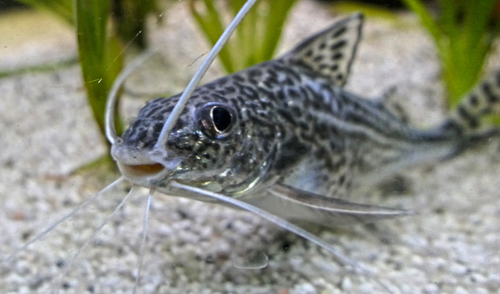
Pictus Catfish
Bluefin Tuna (Thunnus) are among the most remarkable fish in the ocean, known for their size, speed, and migratory prowess. These powerful predators play a crucial role in marine ecosystems. Highly valued commercially, they face significant conservation challenges.
8 15 years
Lifespan
12 cm
Length
Least Concern
Conservation Status
15 km/h
Swimming speed
Carnivorous, Insectivorous
Diet
Local Migration
Migration
Appearance Overview
The Bluefin Tuna is renowned for its large, streamlined body, designed for speed and endurance in the water.
Color
Dark metallic blue on top and silvery-white on the bottom for camouflage.
Body Shape
Torpedo-shaped body optimized for efficient swimming.
Fins
Two dorsal fins, with the second being taller than the first; short pectoral fins.
Length
Up to 10 feet (3 meters), commonly around 6.5 feet (2 meters)
Weight
Up to 1,500 lbs (680 kg), commonly around 550 lbs (250 kg)
Diet
Carnivorous, feeding on a variety of fish, squid, crustaceans, and occasionally on zooplankton and other small organisms.
Feeding Behavior
Aggressive predators, Bluefin Tuna use their speed and agility to hunt. They often feed in coordinated groups, herding prey or charging through schools of fish.
Social Behavior
Highly migratory and known to form large schools, especially during feeding and spawning. They exhibit complex social behaviors, often associating with other tuna species.
Commercial Relevance
Extremely high value, particularly in sushi and sashimi markets, where its fatty flesh is considered a delicacy. This demand drives significant fishing pressure.
Conservation measures
International fishing quotas, regional fisheries management organizations (RFMOs), and marine protected areas. Efforts also include research and monitoring of populations.
Status
Varies by species: Atlantic Bluefin - Endangered; Pacific Bluefin - Vulnerable; Southern Bluefin - Critically Endangered.
Threats
Overfishing is the primary threat, driven by high market demand. Climate change and habitat degradation also pose risks, affecting prey availability and spawning grounds.
Habitat Distribution
Depth Range
0-900 meters (0-2,952 feet), though they are most commonly found in surface to mid-waters.
Geographic Range
Atlantic, Pacific, and Southern Oceans. Atlantic Bluefin are found from Newfoundland to the Gulf of Mexico and the Mediterranean Sea; Pacific Bluefin range from Japan to the western coast of North America; Southern Bluefin are found in the southern hemisphere.
Preferred Environment
Temperate and subtropical waters. They are pelagic, meaning they live in the open ocean, but they often come closer to shore during spawning season.
Reproduction and Life Cycle
Breeding Habits
Spawns in specific areas depending on the species; Atlantic Bluefin have two main spawning grounds: the Mediterranean Sea and the Gulf of Mexico. Spawning typically occurs in warmer waters.
Development Stages
Eggs hatch into larvae, which develop rapidly in plankton-rich waters. Juveniles grow quickly, reaching significant size within their first few years. They transition through several life stages before reaching full maturity.
Fecundity
Highly fecund; a single female can produce millions of eggs per spawning season, releasing them into the water for external fertilization.
Maturity Age
Varies by species; Atlantic Bluefin typically mature between 4-8 years, while Southern Bluefin mature later, around 8-12 years.
Faqs about Pictus Catfish
How long do Bluefin Tuna live?
Bluefin tuna can live up to 40 years, though this varies by species and environmental conditions.
Are Bluefin Tuna fast swimmers?
Yes, they are among the fastest fish in the ocean, capable of bursts of speed up to 43 mph (70 km/h).
Where can Bluefin Tuna be found?
They are primarily found in the Atlantic, Pacific, and Southern Oceans, with specific migratory patterns that vary by species.
Are Bluefin Tuna warm-blooded?
They are warm-blooded, which is unusual for fish. This allows them to maintain higher body temperatures than the surrounding water, aiding in muscle efficiency and speed.
Are Bluefin Tuna populations overfished?
Yes, due to high demand and overfishing, many populations are considered overfished, leading to strict regulations and conservation efforts.
Copyright @ Nature Style Limited. All Rights Reserved.
 English
English